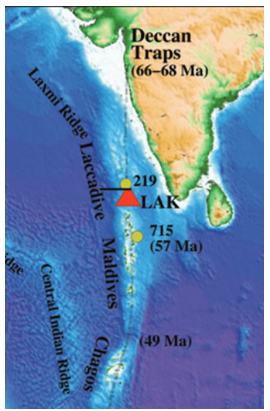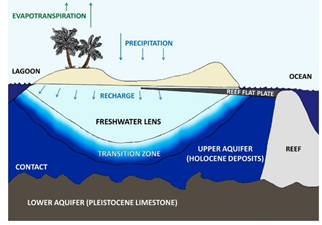

Context
The tiny islands that make up the Union Territory of Lakshadweep are in turmoil. The islanders are upset about a series of recent disruptions in their lives and apprehensive about a set of proposed laws with the potential to alter the very character of the archipelago.
Background
- Known originally as ‘Laccadives’, Lakshadweep is an enchanting group of islands in the Arabian Sea between N. Lat. 8°-12°30’ and between E. Long. 71°-74°. It forms an archipelago in the northern edge of the 2,500 km long, Chagos-Maldive-Laccadive sub-marine mountain ridge
- Destructive human activity, rising temperatures in the Arabian Sea and increasing ocean acidification are pushing the coral ecosystem in Lakshadweep to the verge of breakdown
- Despite heavy rainfall, these islands are acutely water-stressed.
- A tourism push by the developmental activities that ignores these realities will damage these islands.
Analysis
Physical Features
- Located in the Arabian Sea, Lakshadweep is a group of 36 islands comprising of 12 atolls, three reefs, five submerged sand banks and 10 inhabited islands
- The maximum height of the island is 6 metres above the mean sea level.
- The soil of region is sandy.
- There is no rivers or streams, waterfalls, lakes, reservoirs, etc., in the district (entire UT of Lakshadweep is considered as single district)
- The islands are generally aligned from north to south with one exception namely, Andrott, which lies east to west.
Formation of islands
- The origin of the islands is attributed to the theory propounded by the English evolutionist Sir Charles Darwin in 1842. According to him,the origin of these islands can be traced to gradual submergence of some of the volcanic ridge into the Indian Ocean followed by accumulation of coralline deposits on the peaks and craters of these mountains.
- These deposits grew into coral islands resting on submerged mountain tops over a period of time. When the volcanic islands became completely submerged, the atoll was formed encircling the lagoon where, with the action of the wind, waves, reef to currents and temperature, the coral islands were formed.
Lakshadweep: Part of CLR Ridge
- The Lakshadweep, Maldives and Chagos archipelagos form a contiguous mountain ridge in the ocean. TheChagos-Laccadive Ridge(CLR), also known asChagos-Laccadive is a prominentvolcanicridge extending between the Northern and the CentralIndian Ocean.
- This ridge is believed to be a continuation of the Aravalli Mountain range of Rajasthan and Gujarat since the late tertiary times
- The Aravallis formed a great mountain chain in the Precambrian period extending from the Himalayas in the north to Lakshadweep in the South.
Hydrogeology of Lakshadweep
- Ground water occurs under phreatic conditions in these islands occurring as a thin lens floating over the seawater (due to difference in densities) and is tapped by open wells
- The water level fluctuation in these islands is significantly controlled by tides when compared to the groundwater recharge and draft
- The maintenance of a minimum thickness of lens is a critical factor for the upkeep of island groundwater system. The fresh groundwater extraction from island lenses has to be limited to the sustainable yield.
- Cases of increased extraction from these fragile lenses and resultant salinizationwere reported from many islands where pumping activity has been on the increase, especially, during the last three decades
Naturally formedstructures leading to Wetlands
Coral reefs
- Corals are the most dominating that amounts to 69 % of wetland area in Lakshadweep
- Coral reefs are of three types namely; fringing reefs, barrier reef and atolls. The coral reefs of the Lakshadweep islands are mainly atolls except one platform reef of Androth.
- Each island is fringed by coral sands, and is marked by huge, shallow, calm lagoon on the western side that separates it from incoming swells of the outer sea by the wall of a reef made up of massive coral boulders and live corals.
Lagoons
- In Lakshadweep the lagoons are very different from the mainland in the sense that they are actually coral reef lagoons wherein the water body gets enclosed in an atoll or within a barrier reef. The depth of the lagoon is appreciable and available literature indicates that the floor of these lagoons mainly contain the coral debris and calcareous sand
Sand Beach
- In Lakshadweep these sandy beaches are characteristically located on windward side. On the other sides the sandy beaches experience the vagaries of monsoon. These beaches comprise vegetation mainly sweet potato, bay-hops, crabgrass and whistling pine tree
Edaphic condition in the islands
- The soils are geologically very young and rich in calcium carbonates of aquatic origin and poor in silica and sesquioxides. The coral atolls are very rich in phosphate deposit of low grade (13.4 per cent P2O5). The phosphate reserve is estimated as 0.12 million tonnes and it is also reported that a large deposit of calcium carbonate exists in the surrounding lagoons
- Soil depth is limited by the presence of a hard pan or shallow ground water
Agriculture of Lakshadweep
- The islands occupy an area of 3,000 ha. Agriculture is confined only to specific areas around habitations. The soils are medium to deep, alkaline in reaction and low in soil fertility. The land use is dominated by plantation crops like coconut and arecanut. The important crops grown are rice and pulses under rainfed conditions. Suggested interventions for natural resource management for agriculture in the state are as follows:
- Diversification of rice-rice with rice-pulse requiring less water
- Amelioration of alkaline soils
Conclusion
Lakshadweep has an extremely fragile ecosystem and developmental activities there have severe limitations. Besides, the islands have unique traditions and culture, and reforms that could have a bearing on those should not be enforced unilaterally. The government must rethink the proposed reforms and make islanders stakeholders in any future developmental activities.




